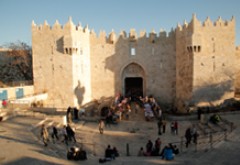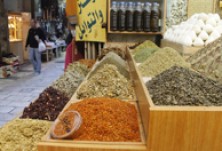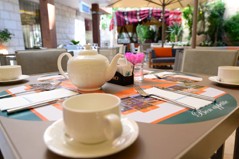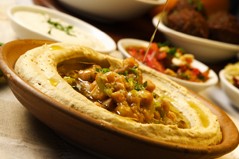The city of Jerusalem is considered the capital city of stuffing and oven-cooking par excellence. It is very true that the Jerusalem cuisine is part of the Levant cities' cuisine. However, it has its own specificities as well. The ladies of Jerusalem have the tendency to stuff all kinds of vegetables and other culinary forms. You can have Mahshi Kusa squash (zukini) stuffed with rice and meat, or Makhshi Kusa squash stuffed with meat and pine nuts only. Both are cooked either in yogurt (concentrated or fresh) or in tomato juice. The same applies to Batiri eggplant (Japanese purple eggplant named after the village of Battir). The ladies of Jerusalem stuff vine leaves, chard leaves, cabbage leaves, lettuce leaves, potatoes, carrots, cucumbers and cucumis, turnip, green pepper, tomato, eggs, chicken, pigeon, lamb, lamb legs, lamb neck, lamb intestines, and even chicken necks. Nothing is beyond stuffing in Jerusalem!
The Jerusalem cuisine also includes many appetizers, some prepared using eggplants, such as Mutabbal and Musakka'a, as well as a whole range of deep-fried vegetables. There is also the Muthawwameh (Garlic paste), Shishbarak (small pastries stuffed with meat), and lentils in flat bread. The list of salads is long and varied, especially that Jerusalem is surrounded by villages that provide fresh vegetables, expanding the list of salads and appetizers.
Among the main dishes for which Jerusalem is famous is Maqlubah (Upside Down), prepared using either eggplant or cauliflower, Mujaddarah (lentils and rice), Mansaf, Maftool, Msakhan, and Qidreh.
Until the second half of the 20th century, Jerusalem homes did not have ovens in their kitchens, and baked foods were sent to the communal kitchen of the neighborhood: These foods included Meat Tray, Kafta (ground lamb with parsley, onions and spices) with Tahini, Kafta with Tomato Sause, Chicken with Tomato Sauce Tray, Meat on Vine Leaves Tray, Tajin, and others. All kinds of pastries were also sent to the communal neighborhood kitchen, including Sfeiha, egg pies, spinach pastry, cheese pastry, etc. One can add to this list a whole range of barbecued meats, poultry, and vegetables.
The communal neighborhood oven also helped prepare sweets in religious occasions. Ka'k and Ma'moul (dates, walnuts, and pistachio semolina and flour pastries) were prepared at home and baked at the communal oven, together with other sweets. Indeed, Jerusalem homes did not know ready-made bread until a few decades ago. The tradition was to prepare the dough at home and send it to the communal oven to be baked.
Jerusalem, like most Levant cities, enjoys normally breakfast plates like Hummus, Foul, Musabbaha, Falafel, and Fatteh. Very few Jerusalem markets do not provide these dishes. The oldest and most famous in the Old City is Abu Shukry's. No visit to the Old City is complete without dropping in.
Jerusalem is particularly known for Ka'k Bissimsim, the round or elongated dough covered with sesame and baked in the traditional oven. It is normally eaten with Falafel, cheese, or oven-baked eggs.
Jerusalem sweets are divided into two groups. The first is home-made sweets, including Ka'k and Ma'moul, Zalabia, Muhallabiyah, Rice Pudding, Sugar Ghee Fatteh, Samolina Halawa, Balutha, Harissah, and Milk Curd. The second group comprises sweets available in the markets, generally known as eastern sweets, including Baklava, Burma, Khdoud Essit, Awwamah, Karabeej Halab, Crow's Nest…etc. The most prominent Palestinian sweet, by far, is the Nablus Knafeh, which has spread all over the Arab east and throughout the world. Jerusalem's unique sweet, however, is Mutabbak, connected in Jerusalem to the Zalatimo family, known to be producing this rich sweet in its shop for the past century and a half. The shop is a well-known address in the City. Among the famous sweet shops in Jerusalem is Ja'far Sweets.







